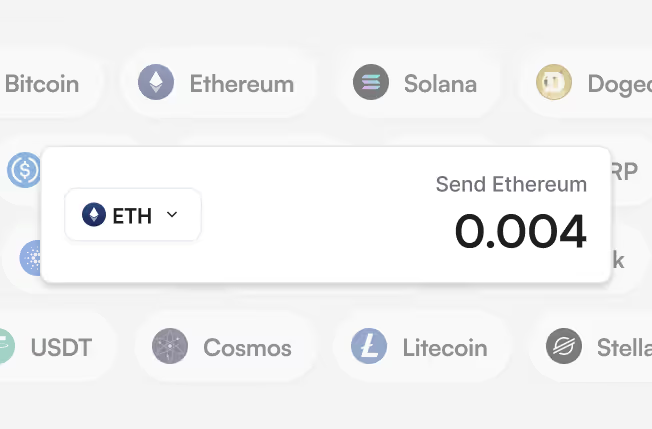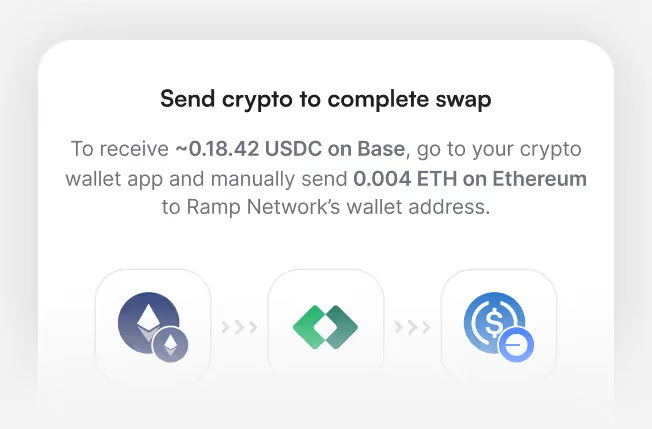


Swap Tether to Bitcoin seamlessly.
Covert Tether (USDT) to Bitcoin (BTC) quickly and securely with Ramp Network – no complex bridges or exchanges needed.


.svg)










Covert Tether (USDT) to Bitcoin (BTC) quickly and securely with Ramp Network – no complex bridges or exchanges needed.


.svg)







Seamlessly swap Tether to Bitcoin without multiple exchanges with Ramp Network - no stress, no confusion, just a few steps you can complete in minutes.

1
Choose Tether (USDT) and Bitcoin (BTC), enter the amount you’d like to swap, and review the live exchange rate before proceeding.

2
Sign up with your preferred method and confirm your country of residence to continue.

3
Ramp Network supports both self-custodial wallets like Ledger or MetaMask and custodial exchange accounts. You stay in full control throughout the process.

4
Transfer the USDT from your wallet. Once the transaction is confirmed on the network, BTC is delivered directly to your selected wallet or exchange account.

Ramp Network supports both self-custodial wallets such as Ledger or MetaMask and custodial exchange accounts.






The flow is built to stay intuitive and straightforward. Ramp Network removes unnecessary crypto jargon, making USDT-to-BTC swaps accessible even for first-time users.
You remain in complete control of your assets. USDT is transferred directly from your wallet, and BTC is delivered to the wallet or exchange account you specify. Ramp Network never holds user funds beyond what’s required for settlement.
Ramp Network operates in major regions including the UK, EU, and US. Network and currency availability are shown clearly during checkout.

Before you finalize your USDT-to-BTC swap, all relevant information, including the exchange rate and applicable fees, is displayed upfront, so you always know exactly what to expect.
*When compared to transferring via an exchange

Tether, better known by its ticker USDT, is the digital world’s version of the U.S. dollar. It’s what people call a stablecoin – a token that’s meant to hold its value rather than fluctuate like most cryptocurrencies. Each USDT is designed to be backed by real-world assets such as cash or short-term treasuries, so one token should always equal about one dollar.
It first appeared back in 2014, long before “stablecoin” became a buzzword. Traders started using it to move dollars across blockchains in minutes instead of waiting days for a bank wire. Since then, it’s become part of crypto’s everyday toolkit – used for remittances, DeFi lending, and even payments for freelancers around the world.
You’ll find Tether running on many networks – Ethereum, Tron, Solana, and others, which helps keep transactions fast and affordable. It isn’t meant for speculation or hype; it’s meant for utility. For most people, USDT is simply a reliable, digital stand-in for traditional money.
Bitcoin (BTC) is the world’s first cryptocurrency, launched in 2009 by the mysterious creator known as Satoshi Nakamoto. Built on blockchain technology, Bitcoin introduced a new way of transferring value online without the need for banks or intermediaries. Its decentralized nature, combined with a fixed supply of 21 million coins, makes it a unique digital asset often referred to as “digital gold.”
Today, Bitcoin is the most recognized and widely used cryptocurrency worldwide. Millions of people use it for trading, investing, and cross-border payments, while businesses across industries accept Bitcoin payments as a secure and transparent alternative to traditional money. Its popularity continues to grow, supported by increasing adoption from financial institutions, mainstream investors, and even governments exploring Bitcoin regulation.
What makes Bitcoin special is its combination of scarcity, security, and decentralization. Unlike fiat currencies that can be printed endlessly, Bitcoin’s supply is limited, creating long-term value potential. Its blockchain is maintained by thousands of nodes across the globe, ensuring transactions remain transparent and resistant to censorship. For many users, Bitcoin represents more than just an investment — it’s a revolutionary step toward financial freedom and the future of money.
The chart displays an indicative, mid-market exchange rate. Effective exchange rate might be different.

Bitcoin needs little introduction at this point. What began in 2009 as an open experiment by someone called Satoshi Nakamoto is now a global financial network that moves value without intermediaries. There’s no company, no central bank – just code, miners, and millions of users verifying every transaction on a public ledger.
Only 21 million Bitcoins will ever exist, and that scarcity has turned it into something like digital gold. But its real strength lies in flexibility: anyone can send or receive BTC from almost anywhere, often in minutes. Over time, people stopped seeing it as a novelty. Freelancers use it for payments, families for cross-border transfers, and institutions as a hedge against traditional market risk.
By 2025, Bitcoin isn’t a futuristic idea – it’s infrastructure. Swapping USDT for BTC today is just another way to move between stability and independence in an open, permissionless system
Bitcoin (BTC) is the world’s first cryptocurrency, launched in 2009 by the mysterious creator known as Satoshi Nakamoto. Built on blockchain technology, Bitcoin introduced a new way of transferring value online without the need for banks or intermediaries. Its decentralized nature, combined with a fixed supply of 21 million coins, makes it a unique digital asset often referred to as “digital gold.”
Today, Bitcoin is the most recognized and widely used cryptocurrency worldwide. Millions of people use it for trading, investing, and cross-border payments, while businesses across industries accept Bitcoin payments as a secure and transparent alternative to traditional money. Its popularity continues to grow, supported by increasing adoption from financial institutions, mainstream investors, and even governments exploring Bitcoin regulation.
What makes Bitcoin special is its combination of scarcity, security, and decentralization. Unlike fiat currencies that can be printed endlessly, Bitcoin’s supply is limited, creating long-term value potential. Its blockchain is maintained by thousands of nodes across the globe, ensuring transactions remain transparent and resistant to censorship. For many users, Bitcoin represents more than just an investment — it’s a revolutionary step toward financial freedom and the future of money.
The chart displays an indicative, mid-market exchange rate. Effective exchange rate might be different.
Customers like you have traded over $1 billion in crypto with Ramp Network.